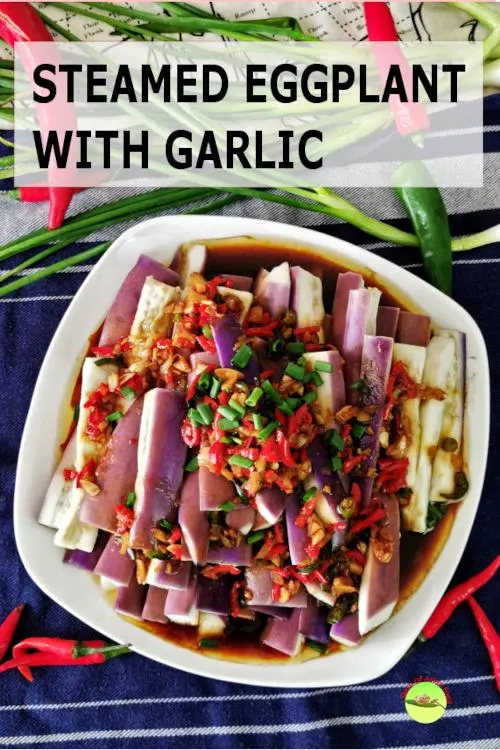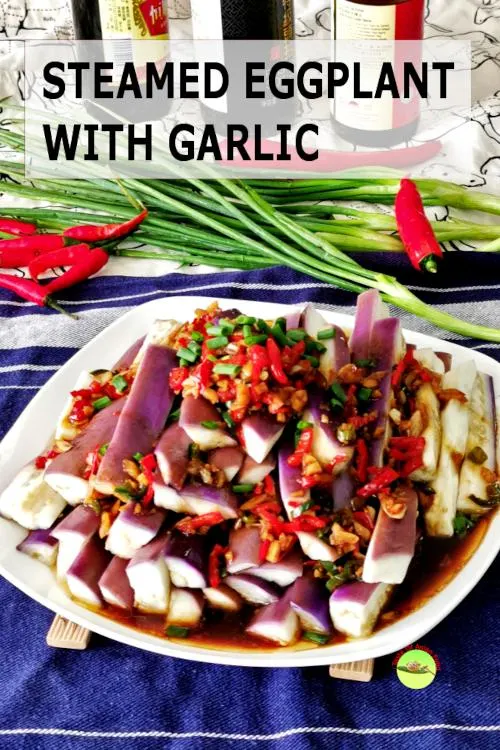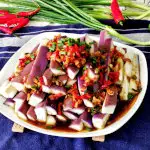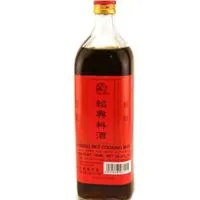Steamed eggplant is the simplest and healthiest among all the eggplant recipes.
I have posted a few eggplant recipes, which are either stir-fried or deep-fried. They are delicious, but if you prefer a lighter and healthier twist, this Chinese steamed eggplant recipe with garlic sauce 蒜蓉蒸茄子 will tantalize your taste buds with its tender texture and savory flavor.
The dressing is a combination of garlic and chilies, vinegar, and soy sauce to achieve the perfect balance of flavors that attack your taste buds.
Let’s get into the details.
Eggplant is also called aubergine in British English, German, French, and Dutch. People in South Asia refer to it as brinjal.

Note: This post may contain affiliate links. Please read my privacy policy for more info. I may receive commissions for purchases made through links in this post. As an Amazon Associate, I earn from qualifying purchases.
How to prepare steamed eggplant with Chinese garlic sauce
The preparation is quite similar to other Chinese eggplant recipes, except the sauce is drizzled on the eggplant, much like salad dressing.
1. Pre-preparation before steaming the eggplants
This step is of utmost importance to preserve the purplish color of the eggplant.
- Remove both ends of the eggplants.
- Cut the eggplants into four to six inches long strips, about half an inch wide.
- Place them into a pot of cold water immediately after cutting, which will prevent the exposed area of the eggplants from turning brown.
- Add a teaspoon of salt and two tablespoons of white vinegar into the water and mix. The salt and vinegar help to retain the purplish color of the eggplant’s skin during cooking.
- Soak the eggplant in the salt and vinegar solution for ten minutes. Remove and drain. You do not need to wash away the salt and vinegar as both are the seasoning for the eggplants.
Note: I have compared the color of the eggplants by soaking them in salt and vinegar solution versus applying a thin layer of oil to the eggplant. The test is to validate the oil method used by some chefs to retain the beautiful purplish color. The result shows that the color is brighter and deeper by soaking them in salt and vinegar water.
2. Steam the eggplants
Steaming is a simple method that yields a cleaner taste than stir or deep frying. It tastes like a salad with dressing.
- Set up a steaming station with a wok and a trivet, or use a steaming pot if you have one.
- Stack the eggplant pieces crisscrossed in a steamer plate to maximize the steam flowing through the eggplants during steaming.
- When the water is boiling, place the eggplants in the steamer.
- Steam for ten to twelve minutes until the eggplants are thoroughly cooked, soft, and tender. This step is essential as any eggplants that are not thoroughly cooked will not taste good. You may pick one (a larger piece to play safe) at the tenth minute to decide whether you want to continue steaming it longer.
- Remove the steamed eggplant pieces and set them aside.
3. Prepare the spicy Chinese garlic sauce
a. Main ingredients for the Chinese garlic sauce recipe
The main ingredients of this sauce are garlic and chilies.
Coarsely chop the garlic and set it aside. I use one bulb of garlic which is about 50g/2oz, before peeling. Feel free to increase the amount if you like the taste of garlic.
Besides garlic, I also add some finely chopped ginger to enhance the flavor,
There are two types of chilies in this Chinese steamed eggplant recipe. The larger type is Thai chili which is about four to six inches long. These chilies are not very hot, which is why I use them for their flavor. I use both green and red chilies to make the sauce more colorful. Remove the pith and seeds by cutting them in half lengthwise, then cut them into tiny pieces.
The second type is the smaller chilies called bird’s eye chili (cili padi). These chilies are much smaller, about one to two inches long but are very hot. Remove the stem and cut them crosswise into thin rings.
Note: Adjust the level of hotness based on your ability to take on the heat of chilies. I only use three bird’s eye chilies in this recipe, but many locals can take much hotter food than me.
b. Seasoning for the Chinese garlic sauce
The seasoning consists of some typical flavoring agents available in most Chinese kitchen pantries. The ingredients are light soy sauce, oyster sauce, black vinegar, Shaoxing wine, sugar, sesame oil, and ground white pepper. The combination is flexible, and these items can be substituted or omitted according to your preference. However, there are a few general rules that should follow:
- Light soy sauce should always be one of the ingredients. Use more light soy sauce if you want to make it saltier, as it also enhances the flavor.
- You can substitute oyster sauce with the vegetarian version made with mushroom extract. The vegetarian version tastes and looks very similar to the authentic oyster sauce (from oyster extract), and therefore is also marketed as a vegetarian oyster sauce.
- Vinegar is another essential seasoning. Try to get the Chinese Chinkiang vinegar 镇江香醋 for the authentic taste. You can use balsamic or wine vinegar as the substitute. Make sure to add some sugar to balance the sourness of vinegar.
- Shaoxing wine is optional.
- If you want to make a Szechuan-style sauce, add one teaspoon of Szechuan peppercorn to the oil and lightly stir fry it for a minute, then remove the peppercorns and use the oil to continue sauteing the garlic. Besides, add two teaspoons of Szechuan chili oil into the garlic sauce will drastically change its overall taste.
c. Prepare the Chinese garlic sauce
- Heat two tablespoons of vegetable oil in a pan.
- If you prefer to add some Szechuan flavor, add a teaspoon of Szechuan peppercorn to the oil and lightly stir-fry it for a minute. Let the unique flavor of these peppercorns release into the oi. Remove the peppercorns, and continue sauteing the garlic. Otherwise, omit the Szechuan peppercorns and saute the garlic for one to two minutes over low heat or until aromatic.
- Add the chopped ginger to the pan and saute with the garlic.
- Measure the seasoning ingredients mentioned in the last section and mix with the garlic and ginger.
- When it returns to a boil, pour the chopped chili into the pan and give it a few quick stirs. Let it cook for half a minute, then remove it from heat.

4. Assemble and serve
- Arrange the eggplant pieces on a serving plate, single layer.
- Spoon part of the sauce to cover the eggplants, then continue to lay the second layer. Spreading the sauce on the first layer before arranging the second layer will let the eggplant absorb the sauce and enable the chili and garlic distributed equally to all the pieces.
- Continue adding layers of eggplant to the top, and drizzle the remaining sauce on top.
- Garnish with some thinly cut scallion to serve.
Other related recipes to steamed eggplant
You are most likely also love the following recipes if you prefer the steaming method in your cooking:
Steam minced pork with salted egg recipe is a lifesaver when you do not feel like spending too much time cooking. You can get it ready on the dining table within half an hour. (Note: use chicken breast meat as the substitute if you do not eat pork).
Steamed chicken with mushrooms is a home-cooked dish popular among the Cantonese. The gravy is the most satisfying part of the dish, as you can finish eating a bowl of steamed rice just with the gravy.
Steam the whole fish with the traditional Cantonese steamed fish sauce. You can use the steamed fish sauce for fish fillet if you like it boneless.

Steamed eggplant with garlic sauce
Steamed eggplant is the simplest and healthiest among all the eggplant recipes.
This Chinese steamed eggplant recipe with garlic sauce 蒜蓉蒸茄子 will tantalize your taste buds with its tender texture and savory flavor.
Ingredients
Ingredients A (for the eggplant)
- 600g eggplant
- 1 tsp salt
- 2 tbsp white vinegar
Ingredients B (for the garlic sauce)
- 2 tbsp oil
- 1 tsp Szechuan peppercorn (optional)
- 1 bulb of garlic, coarsely chopped
- 2 large red chilies, cut into short pieces
- 1 large green chilies, cut into short pieces
- 3 bird’s eye chilies, cut into thin rings
- 1 tsp chopped ginger
Ingredients C (seasoning for the sauce)
- 1.5 tbsp light soy sauce
- 2 tbsp oyster sauce
- 2 tbsp black vinegar
- 1 tsp sugar
- 2 tbsp Shaoxing wine
- 1 tsp sesame oil
- 1/4 tsp ground white pepper
- 2 tsp Szechuan chili oil (optional)
Ingredients D (garnish)
- Some scallion to garnish
Instructions
- Remove both ends of the eggplants. Cut them into four to six inches long strips, about half an inch wide. Soak in the salt and vinegar solution for ten minutes. Remove and drain.
- Stack the eggplant pieces crisscrossed in a steamer plate.
- Steam for ten to twelve minutes. Set aside.
- Saute the garlic and ginger with 2 tbsp of oil until it turns aromatic.
- Add the seasoning (C) to the pan.
- When it returns to a boil, add the chopped chili, stir and cook for half a minute, then remove it from heat.
- Arrange the eggplant pieces on a serving plate, single layer.
- Spoon part of the sauce to cover the eggplants, then continue to lay the second layer, followed by the sauce, so that the sauce is distributed equally to all the eggplant pieces.
- Garnish with some thinly cut scallion to serve.
Recommended Products
As an Amazon Associate and member of other affiliate programs, I earn from qualifying purchases.
Nutrition Information:
Yield: 3 Serving Size: 1Amount Per Serving: Calories: 260Total Fat: 15gSaturated Fat: 1gTrans Fat: 0gUnsaturated Fat: 12gCholesterol: 0mgSodium: 1657mgCarbohydrates: 31gFiber: 7gSugar: 13gProtein: 5g
This data was provided and calculated by Nutritionix on 3/26/2021




KP Kwan
Saturday 27th of March 2021
Hi, this is KP Kwan. I am happy to see you in this comment area, as you have read through my recipe. I am pleased to reply to any questions and comments as soon as possible.